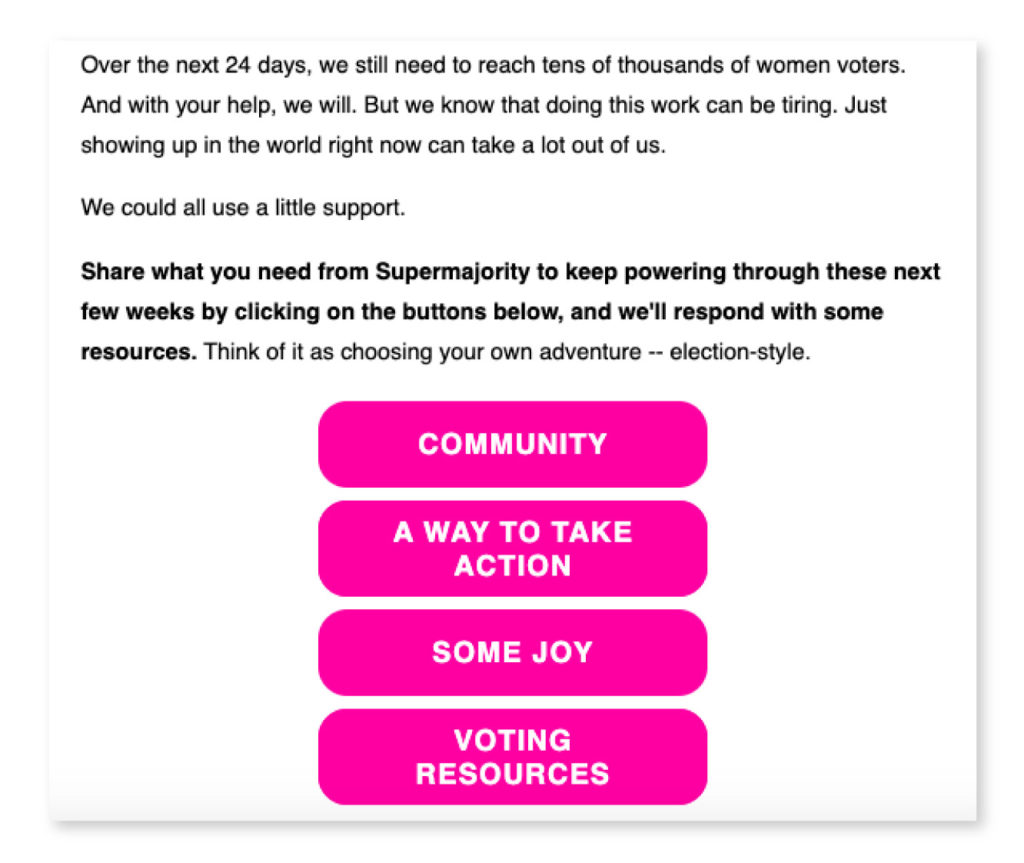End-of-year fundraising season is upon us.
And whether that invokes some ominous music or a burst of confetti in your mind, much of our focus in the coming weeks will be on how our supporters respond. It’s been a long and difficult year for millions of people. With COVID-19 cases at an all-time high, the goodwill and holiday cheer in which we often ground our year-end strategies looks a little different this year.
We know we have a job to do. But how can we hit our fundraising targets while giving supporters the space and empathy they need in this moment? Here are a few guidelines to help make sure you’re putting people first:
1. Empathize, creatively.
As you sit down to write an email or launch a social media campaign, ask yourself: Who’s reading this and how might they be feeling? Matches, deadlines, catchy subject lines — they no doubt work with certain supporters, but we also must consider the hardship our donors are going through now and beyond the pandemic.
Perhaps that email recipient was recently laid off, or is struggling with their mental health, or doesn’t know how they will see their family this holiday season. They are still committed to your cause despite their struggles, but our messaging and strategies must evolve to meet them where they are.
Our recommendation: Prioritize stories told from real people. Find ways to deepen your connections and acknowledge the hardships that everyone is facing. We love this example:

2. Don’t only ask for money.
Digital is working harder than ever this year, and we know you probably have an ever-growing goal for online fundraising, leading to more donation asks on the email calendar. But diminishing returns are a real thing — especially in a year like this when people are just plain exhausted.
Engagement and stewardship are 1000x more crucial this year!
Engaging content reminds subscribers that they like our content while stewardship reminds supporters that we like and appreciate them. Plus, you’d be surprised how much revenue will come in through a post-action daisy chain, i.e. when a donor lands on a donation form after completing a survey or other online engagement.
So this December, add an extra “thank you” message after a donation, send a note from someone who feels the impact of your supporters’ generosity, or share a fun quiz to keep people coming back for more.
3. Give your supporters a break.
This tactic is a bit riskier, but hear me out: Give subscribers an opportunity to opt out of this fundraising season. Not many will take the offer, but you can bet many more will appreciate it, and you will probably retain a good number of supporters who may have otherwise unsubscribed altogether.
Include a link in the footer of your emails and on your unsubscribe page to give your donors the option to take a break from fundraising for a limited amount of time — it could be two weeks or it could be until after the new year. The ask doesn’t need to be fancy; a simple offer will do the trick:

4. The good, appreciated type of “suppression.”
As digital fundraisers, we can’t forget to “read the room.” That will guide your end-of-year suppression strategy. Here are a few questions to ask:
- Is there a certain segment of donors who have (for many years) only given one annual gift at the end of the year? Identify those donors! Once they make their initial contribution, give them some space.
- Haven’t gotten much engagement from your non-donor file? Keep your deliverability safe for more reliable donors by suppressing inactive subscribers from the bulk of your emails.
- Do certain donors only give directly on your website or through another channel? Diversify where you’re asking for money — like SMS or paid ad retargeting —so you aren’t flooding the inbox of someone who rarely logs in.
While budgets and end-of-year deadlines loom over us, we must remember that developing connection and community with our supporters is part of our jobs and if we don’t prioritize that in a year like 2020, it could have long-term and far-reaching consequences.
Good luck! Take care of your supporters — and yourselves — this year. And don’t hesitate to reach out if you need any help. We’re here for you.
Want to discuss your end-of-year strategy? Let’s chat.